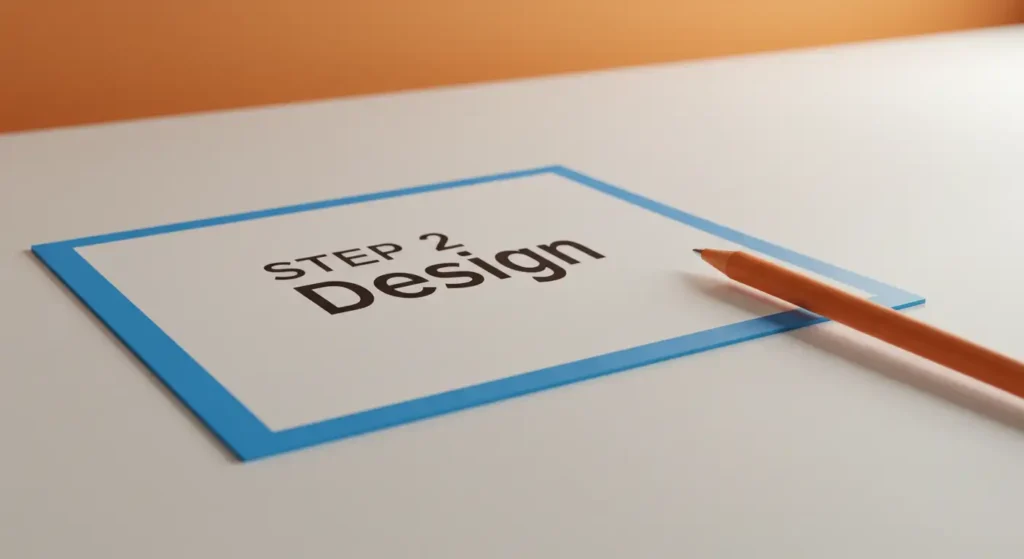Thinking about building a new website? It might seem like a daunting task, but a successful website isn’t just a result of great code; it’s the outcome of a structured, well-thought-out process. By breaking it down into manageable steps, you can turn your vision into a reality.
Here’s a detailed look at the five key stages of the website creation process, from initial idea to final launch.

Step 1: Planning and Strategy
This is the most critical phase. Just like you wouldn’t build a house without a blueprint, you shouldn’t build a website without a solid plan.
Define Your Goal: What is the purpose of your website? Is it to sell products, generate leads, provide information, or showcase a portfolio? A clear objective will guide every decision that follows.
Identify Your Target Audience: Who are you building this for? Understanding your ideal user’s needs and behaviors will influence your content, design, and user experience (UX).
Create a Sitemap: This is a visual map of your website’s structure. It shows all the pages and how they are hierarchically linked. It’s the blueprint that ensures a logical flow for both users and search engines.
Create a Wireframe: Once the sitemap is ready, you’ll create a wireframe for each key page. Think of it as a low-fidelity sketch or a blueprint for a single room. It focuses on the layout of elements like headers, buttons, and text blocks, without any colors or imagery.

Step 2: Design
With a plan in place, it’s time to bring your website to life visually.
UI/UX Design: This phase focuses on both the look and feel. UI (User Interface) design is about the visual elements—colors, fonts, and button styles. UX (User Experience) design is about how easy and intuitive it is to use the site.
Create Mockups & Prototypes: Designers will create high-fidelity mockups based on your wireframes. These are static images of what the final website will look like. Prototypes add a layer of interactivity, allowing you to click through and experience the user flow before a single line of code is written.

Step 3: Development
This is where the design becomes a functioning website.
Front-End Development: This is the part of the website that users interact with directly. Developers use HTML to structure the content, CSS to style it, and JavaScript to add interactive features and animations.
Back-End Development: This is the “behind-the-scenes” work that handles data storage, server logic, and user authentication. It’s what makes dynamic elements like user accounts, shopping carts, and content management systems (CMS) work.
CMS Integration: Many websites today are built on a CMS like WordPress. This allows you or your clients to easily add, edit, and manage content without needing to know how to code.

Step 4: Testing & Launch
Before the big reveal, you need to make sure everything is perfect.
Thorough Testing: This is a crucial step. You’ll test everything from functionality (do all the buttons and forms work?) and cross-browser compatibility (does it look good on Chrome, Firefox, and Safari?) to mobile responsiveness and performance (is it fast enough?).
Content Migration: All the content you planned in Step 1—the text, images, and videos—is now added to the live site.
Go-Live: Once all tests pass, the website is uploaded to a server, and the domain name is configured to point to it. Congratulations, your website is now live!

Step 5: Maintenance and Management
The work doesn’t stop after the launch. A successful website is a living, breathing entity that requires ongoing care.
Regular Updates: Keep your CMS, plugins, and themes updated to patch security vulnerabilities and ensure everything runs smoothly.
Security & Backups: Regularly back up your website data and monitor for security threats to protect your investment.
Content Strategy: Continue to add fresh content. This helps with search engine rankings and keeps your audience engaged.
Performance Monitoring: Use analytics tools to track website traffic, user behavior, and site speed. This data helps you make informed decisions for future improvements.
By following this structured approach, you can navigate the complexities of website creation and build a powerful online presence that serves your goals for years to come.

